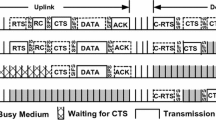Abstract
Carrier sense multiple access with improvised collision avoidance (CSMA/iCA) has recently been proposed as an enhancement to CSMA/CA. It has been reported to be superior than the legacy counterpart in terms of throughput efficiency, packet transmission delay and quantitative fairness index. Nevertheless, the superiority has been shown assuming ideal network conditions: error-free physical layer (L1) and saturated (always non empty) queue at medium access control layer (L2). These strict assumptions, however, do not accurately hold in the real-world Wireless Local Area Networks since the wireless medium is generally error-prone and the arrival of the packets at L2 queue is generally bursty resulting in non-saturated queue occupancy. Thus, the reported performance, especially throughput, in such typical L1/L2 settings is not complete to understand the performance benefit that CSMA/iCA offers under the realistic network settings. In this paper, we relax the aforesaid ideal assumptions and present a cross-layer (L1/L2) performance analysis. Our cross-layer analytical model considers the effect of Rayleigh fading induced bit errors in L1 and non-saturated queue occupancy due to Poisson packet arrival at L2 queue. By virtue of the validated numerical results, we show that the CSMA/iCA consistently retains its throughput gain over CSMA/CA for the non-ideal wireless settings as well.
Similar content being viewed by others
References
IEEE Std. 802.11-2007. (2007). Part 11: Wireless LAN medium access control (MAC) and physical layer (PHY) specifications.
Pudasaini, S., Shin, S., & Kim, K. (2012). Carrier sense multiple access with improvised collision avoidance and short term fairness. Wireless Networks. doi:10.1007/s11276-012-0442-3.
Pudasaini, S., & Shin, S. (2011). Cross layer analysis of CSMA/iCA based wireless local area network. In third international conference on ubiquitous and future networks (pp. 246–251).
Proakis J. G. (2000) Digital communications. McGraw Hill, New York
Mahasukhon, P., Hempe, M., Sharif, H., & Chen, H. (2007). BER analysis of 802.11b networks under mobility. In IEEE international conference on communications (pp. 4722–4727).
Bianchi G. (2000) Performance analysis of the IEEE 802.11 distributed coordination function. IEEE journal on selected areas in communications 18(3): 535–574
Ni Q., Li T., Turletti T., Xiao Y. (2005) Saturation throughput analysis of error-prone 802.11 wireless networks. Wireless communications and mobile computing 5(8): 945–956
Network Simulator. http://www.isi.edu/nsnam/ns
Daneshgaran F., Laddomada M., Mesiti F., Mondin M., Zonolo M. (2008) Saturation throughput analysis of IEEE 802.11 in the presence of non ideal transmission channel and capture effects. IEEE Transaction on Communications 56(7): 1178–1188
No adhoc routing agent (NOAH). http://icapeople.epfl.ch/widmer/uwb/ns-2/noah.
Author information
Authors and Affiliations
Corresponding author
Rights and permissions
About this article
Cite this article
Pudasaini, S., Shin, S. Cross-Layer Performance Analysis of CSMA/iCA Based Wireless Local Area Network. Wireless Pers Commun 67, 63–77 (2012). https://doi.org/10.1007/s11277-012-0800-6
Published:
Issue Date:
DOI: https://doi.org/10.1007/s11277-012-0800-6




